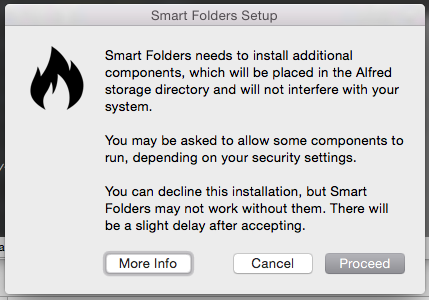Exceptions and Errors on Installation
Upon installation, the Bundler will ask the user for permission to install.
If the user presses the More Info button, the script will be
killed, and the explanation page will be opened
in a browser. If the user presses Cancel, then the Bundler will
throw an exception (AppleScript, PHP,
Python, and Ruby) or will trigger an error
(Bash).
It is advised that you catch the exception so that you can either
(1) proceed without the Bundler, or (2) kill the script and notify the user
that the workflow will not work without the Bundler installed. If you are using
the Bash Bundler, then you should
trap the error, which returns the error code 23.
The error codes 21 and 22 indicate other installation
failures, respectively: (21) no Internet connection and
(22) corrupted installation file.
try
--# Try to initialize the bundler,
--# and so install it if necessary
--# Load the bundlet's script
set bundlet to load script (POSIX path of ((path to me as text) & "::")) & "alfred.bundler.scpt"
--# Use the bundlet's `load_bundler()` function to load the bundler
set bundler to bundlet's load_bundler()
on error emsg number enum
if enum = 23 then
--# If the user stopped installation,
--# take whatever action you see fit.
--# Like simply stopping the workflow:
return
--# Or, display a dialog:
display dialog "This workflow will not work without the Alfred Bundler."
else if {21, 22} contains enum then
--# If there was a problem during installation,
--# maybe display a dialog telling the user what happened
display dialog emsg
end if
end try
--# Continue with the rest of your workflow,
--# using the `bundler` variable to access
--# the bundler's various methods.function bundler_installation_error() {
# The line number that had the error
line_number=$1
# The exit status (to check between 21, 22, and 23)
exit_status=$2
# Do more error handling here.
# Maybe send an error message to STDERR
echo "There was an error" >&2
}
# Capture error codes 21, 22, and 23
trap 'bundler_installation_refused ${LINENO} ${$?}' 21 22 23
# Initialize the Bundler; if there is an error, then the error
# handler will catch it.
. alfred.bundler.sh
# Remove the traps; you might not even worry about this
trap - 21 22 23require_once( 'alfred.bundler.php' );
try {
// Initialize the bundler object, which will install the bundler
// if necessary.
$b = new AlfredBundler( [ 'wf_log' => TRUE ] );
} catch (Exception $e) {
// Do error handling here.
// Maybe set a global variable that indicates the bundler wasn't
// installed and try to continue.
$GLOBALS[ 'bundler' ] = FALSE;
// Or maybe send something to the console and exit.
file_put_contents( 'php://stderr',
'Cannot continue without the Alfred Bundler installed.' );
die();
}
// Continue with the code.INSERT CODE HERE TO CATCH THE EXCEPTIONrequire_relative 'alfred.bundler.rb'
begin
b = Alfred::Bundler.new
rescue Alfred::BundlerInstallError
# Do error handling here.
# Maybe set a global variable that indicates the bundler wasn't
# installed and try to continue.
ENV['bundler'] = false
# Or maybe send something to the console and exit.
abort("Cannot continue without the Alfred Bundler installed.")
end
# Continue with the code.
An example AppleScript confirmation dialog.
Notice the workflow icon (just a testing icon) and the workflow name appearing in the dialog.
Loading Patterns
Obviously, the Bundler requires an Internet connection to download and install any needed assets. In light of this, there are two main approaches exist for implementation.
Lazy Loading
Lazy Loading calls assets only just before they are needed and not sooner. The lazy pattern allows for a more performant script; instead of a long load time at first run (because of downloading assets), the script will distribute the download times across its execution. However, there is the possibility that the user will not have an Internet connection when the asset is called, which will make the script run slower (as it waits for timeouts) and might not load key assets for the workflow to run.
Eager Loading
Eager loading is the opposite of Lazy Loading in that it loads all of the assets immediately upon execution. These assets might not be used (depending on the conditional logic of the script), which will slow the script. Also, the first run of the script will take longer as it needs to download more. After the first run, however, the aspects of the workflow that rely on the Bundler will not need an Internet connection.
Recommendation
If your workflow requires an Internet connection to function (i.e. interacting with a remote API), then you should implement a Lazy Loading pattern. Conversely, if your script is meant to function completely offline, you should use the Eager Loading pattern.